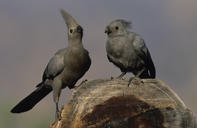
Name
Grey go-away bird (Corythaixoides concolor), was previously known as the grey lourie.Grey Go-away Bird Appearance
The grey go-away bird is a uniform all grey bird with a shaggy crest. The legs, feet and bill are black.Grey Go-away Bird Diet
The grey go-away bird feeds on leaves, flowers, fruit, buds and the occasional small invertebrates. They are agile birds and run along tree branches when feeding. The grey go-away bird is an important seed disperser for a lot of fruit trees. This bird will practise geophagia, eating of soil, to get the nutrients that are lacking in its diet.Grey Go-away Bird Breeding
Both sexes of the grey go-away bird build the nest, hidden in dense foliage in a tree. The nest is a shallow, twig platform, normally unlined. The female lays three eggs that are incubated by both parents for around 28 days. The female broods at night. The chicks fledge at around 25 days from hatching and become independent at around 55 days.Grey Go-away Bird Behaviour
The grey go-away bird gets its common English name from its call, that sounds like the bird is telling you to go away. It is a nasal call “g’wa-ay, g’wa-ay”. This is a highly vocal bird and will call whenever it is disturbed.
These birds are gregarious and move in groups of up to 20 birds. Go-away birds need to drink regularly and will flock at water sources. The grey go-away bird roosts in small groups at night. The grey go-away bird can often be seen laying on the ground with its wings and tail spread, also having dust “baths”.